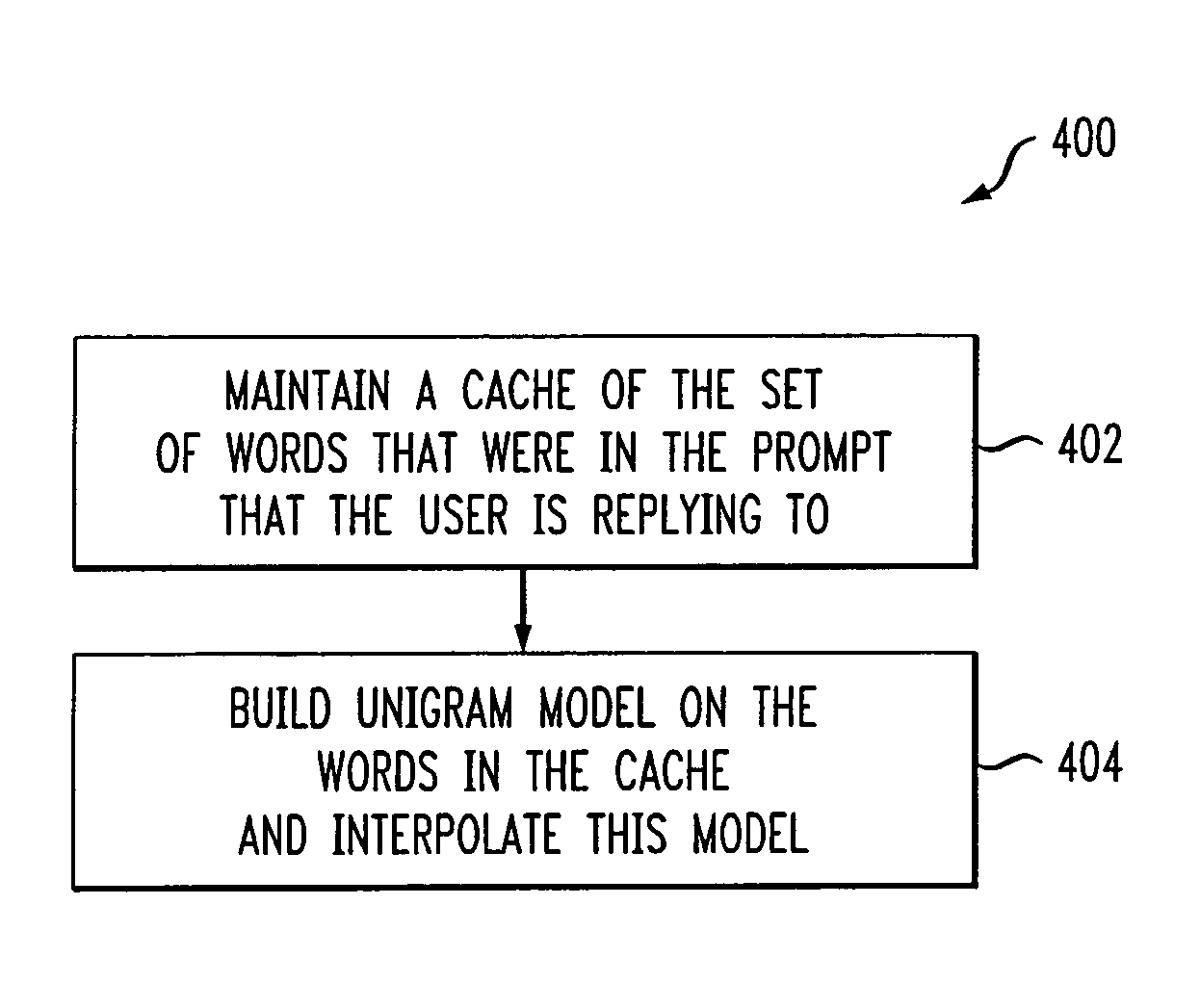Methods and apparatus for generating dialog state conditioned language models
a language model and model state technology, applied in the field of language modeling, can solve the problems of large number of trigrams that cannot be seen, influence the overall quality of the model, poor estimation, etc., and achieve the effects of improving language modeling, improving usability of the dialog system, and improving language modeling
- Summary
- Abstract
- Description
- Claims
- Application Information
AI Technical Summary
Benefits of technology
Problems solved by technology
Method used
Image
Examples
first embodiment
[0032]Referring now to FIGS. 2A and 2B, flow diagrams illustrate a method of conditioning a language model on the state of the dialog according to the present invention. More specifically, FIGS. 2A and 2B illustrate a linear interpolation method 200 for accomplishing this task.
[0033]In accordance with the linear interpolation method, in step 202 of FIG. 2A, the training data which is labeled by state is divided into different sets depending on the state to which the training data belongs. It is to be understood that the state information used for labeling is the “state” as maintained within the dialog system. The state of the system is an indication of what the system expects the user to provide. The training data labeled by state is obtained by having people call the dialog system. Each user utterance occurs when the system is in a particular state. The state in which the user utterance occurs is stored and the user utterance is transcribed to language model training data labeled w...
second embodiment
[0039]Referring now to FIG. 3, a flow diagram illustrates a method of conditioning a language model on the state of the dialog according to the present invention. More specifically, FIG. 3 illustrates a maximum entropy / minimum divergence modeling method 300 for accomplishing this task.
[0040]The maximum entropy / minimum divergence modeling approach of the invention builds trigram models with features that depend on the state of the dialog. When the space of values that the state can take is large, it is more natural to build exponential models with feature functions incorporating information of the state of the dialog. Such models built in accordance with the invention are of the form:
[0041]P(wiwi-1,wi-2,s,p)=(P(wiwi-1,wi-2)exp(∑jλjfj(wi,s,p))Z(λ,s,p,wi-1,wi-2)).
[0042]In the above equation, s refers to the state, p refers to the prompt, fj are binary valued functions and Z(λ, s, p, wi−1, wi−2) is a normalizing term chosen so that ΣwP(w|wi−1, wi−2, s, p)=1 for all s, p, wi−1, w...
third embodiment
[0046]Referring now to FIG. 4, a flow diagram illustrates a method of conditioning a language model on the state of the dialog according to the present invention. More specifically, FIG. 4 illustrates a prompt word caching method 400 for accomplishing this task.
[0047]In accordance with this way of using state information, the idea is that the user is more likely to use words / phrases that were in the prompt than others. Thus, in accordance with this approach, as shown in step 402, a cache of the set words that were in the prompt that the user is replying to is maintained. Then, the probability of words that occur in the prompt is increased. This is accomplished, in step 404, by building a unigram model on the words in the cache and interpolating this model with a baseline model. The baseline model referred to here is a regular trigram language model trained from all data available for the domain. In general, this model could also include state information as described in the first em...
PUM
 Login to View More
Login to View More Abstract
Description
Claims
Application Information
 Login to View More
Login to View More - R&D
- Intellectual Property
- Life Sciences
- Materials
- Tech Scout
- Unparalleled Data Quality
- Higher Quality Content
- 60% Fewer Hallucinations
Browse by: Latest US Patents, China's latest patents, Technical Efficacy Thesaurus, Application Domain, Technology Topic, Popular Technical Reports.
© 2025 PatSnap. All rights reserved.Legal|Privacy policy|Modern Slavery Act Transparency Statement|Sitemap|About US| Contact US: help@patsnap.com



